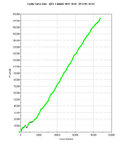Hi,
I am a former floor trader trying to make the transition onto the screen. I have opened an account with Transact futures in Chicago and am provided a nice front end (simple and fast) and a decent commission structure. My basic approach is to scalp for ticks and generally play the "transition" game...in other words try to get filled as the market transits from bid to offer or vice versa. This strategy as some may have guessed is typical of a floor scalper.
The major difference between these two environments is the implementation of some kind of FIFO/queuing system, depending on which exchange you trade electronically. My first impression so far is this: it isn't easy!!
This is my basic strategy:
1. Trade a product which is highly correlated to another product, then key off the more liquid one. In other words, a follower/leader strategy. An example would be trading Bobl and keying of the Bund, or Stoxx against the DAX.
2. Watch T+S like a hawk.
3. Trade the transition - as market goes from bid to offer or vice versa, try to get a fill. In anticipation of getting filled, I will put my buy order (in this case, I am short from a higher price) below market, so I can get a good position in the queue.
I reckon in many ways this is like a job. Everyday you gain practical experience and thru the process of observation you get to see "patterns" and notice the various "tricks of the trade." I have only been going at this for a couple of weeks (from home) and I am down small.
I was hoping for any feedback, advice or constructive criticism from other more experienced traders, particularly those working in the arcades 🙂
I certainly appreciate any insight you may have.
Thank you,
Gerard
P.S This thread seemed like the most appropriate place to post. My apologies if this is not...can the moderator contact me and I will do the necessary.
I am a former floor trader trying to make the transition onto the screen. I have opened an account with Transact futures in Chicago and am provided a nice front end (simple and fast) and a decent commission structure. My basic approach is to scalp for ticks and generally play the "transition" game...in other words try to get filled as the market transits from bid to offer or vice versa. This strategy as some may have guessed is typical of a floor scalper.
The major difference between these two environments is the implementation of some kind of FIFO/queuing system, depending on which exchange you trade electronically. My first impression so far is this: it isn't easy!!
This is my basic strategy:
1. Trade a product which is highly correlated to another product, then key off the more liquid one. In other words, a follower/leader strategy. An example would be trading Bobl and keying of the Bund, or Stoxx against the DAX.
2. Watch T+S like a hawk.
3. Trade the transition - as market goes from bid to offer or vice versa, try to get a fill. In anticipation of getting filled, I will put my buy order (in this case, I am short from a higher price) below market, so I can get a good position in the queue.
I reckon in many ways this is like a job. Everyday you gain practical experience and thru the process of observation you get to see "patterns" and notice the various "tricks of the trade." I have only been going at this for a couple of weeks (from home) and I am down small.
I was hoping for any feedback, advice or constructive criticism from other more experienced traders, particularly those working in the arcades 🙂
I certainly appreciate any insight you may have.
Thank you,
Gerard
P.S This thread seemed like the most appropriate place to post. My apologies if this is not...can the moderator contact me and I will do the necessary.

